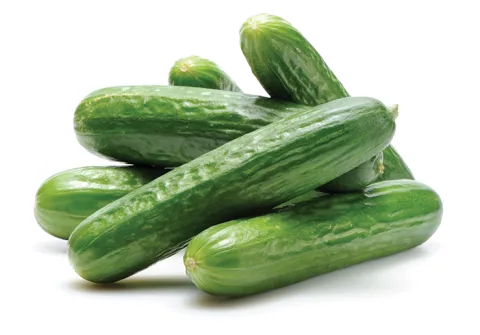Growing
Sow seeds outdoors in late May when the soil is warm and after the danger of frost has passed. Sow seeds 4 to 6 inches apart, ½ inch deep, in rows 5 to 6 feet apart. Thin plants to stand 12 inches apart.
An alternate method is to sow seeds in hills. Sow four to five seeds per hill, spacing hills 3 to 5 feet apart in rows 4 to 5 feet apart. Thin to two plants per hill.
For a quicker harvest, seeds may be sown indoors in peat pots or cell packs three weeks before transplanting. Set plants 12 inches apart, being careful not to disturb the plant roots.
Prevent diseases by sowing disease-resistant varieties, avoiding overhead irrigation and rotating crops. Monitor for cucumber beetles, which spread bacterial wilt disease.
For more information about growing vegetables, see www.ndsu.edu/agriculture/extension/extension-topics/gardening-and-horticulture.
Harvesting
Cucumbers should be picked often to promote a continuous yield. Avoid harvesting while the leaves are wet to prevent the spread of plant diseases.
Storing
Cucumbers are best stored in humid, 55 F areas such as a cool basement room. They are fresh for a week in the refrigerator.
Preserving
Preserve cucumbers by pickling. Canning cucumbers is best done within 24 hours of picking them. Be sure to rinse the cucumbers thoroughly.
Adding vinegar makes cucumbers acidic for safe pickling. This ingredient also provides flavor. Use 1- to 1½-inch cucumbers for making gherkin pickles, and 4-inch cucumbers for dills.
Remember to only use recipes with tested proportions of ingredients. Altering ingredient amounts may change the flavor, texture and level of acidity required to make a safe canned product. Visit the NDSU Extension website, www.ag.ndsu.edu/food, for more information about safe pickling and canning procedures for various crops.
Nutrition
One cup of cucumber slices has 15 calories, 0 g fat, 0 g protein, 4 g carbohydrate, less than 1 g fiber and 0 mg sodium.
Recipes
Key to abbreviations
c. = cup
tsp. = teaspoon
Tbsp. = tablespoon
oz. = ounce
lb. = pound(s)
gal. = gallons
qt. = quarts
g = gram
mg = milligram
Tzatziki Sauce
1 c. plain, nonfat Greek yogurt
¾ c. cucumber, diced
1 Tbsp. lemon juice
1 garlic clove, minced
1 Tbsp. fresh dill, chopped (1 tsp. dried dill)
½ tsp. black pepper
Combine all ingredients and chill.
Makes six servings. Each serving has 25 calories, 0 g fat, 3 g carbohydrate, 4 g protein, 0 g fiber and 20 mg sodium.
Cucumber Spread (or Dip)
4 large cucumbers (3 to 4 cups, diced)
½ tsp. salt
8 oz. plain cream cheese
½ c. mayonnaise (or substitute sour cream)
2 Tbsp. dill weed
1 Tbsp. onion, diced
Chives, mint or parsley, chopped (optional)
Rinse cucumbers, peel then remove seeds and dice. Combine with salt and allow to rest 1 hour, draining excess liquid. Combine cream cheese, mayonnaise, dill weed and onion. Top with optional herbs, if desired. Serve with crackers, vegetables or as a sandwich spread.
Makes 12 servings (about 1/3 cup). Each serving has 100 calories, 9 g fat, 2 g protein, 4 g carbohydrate, 0 g fiber and 220 mg sodium.
(Thanks to Joan Bishoff for this recipe.)
This recipe is from the U.S. Department of Agriculture’s “Complete Guide to Home Canning,” Agriculture Information Bulletin No. 529.
Quick Fresh-pack Dill Pickles
8 lb. 3- to 5-inch pickling cucumbers
2 gal. water
1¼ c. canning or pickling salt
1½ qt. vinegar (5%)
¼ c. sugar
2 qt. water
2 Tbsp. whole mixed pickling spice
About 3 Tbsp. whole mustard seed (1 tsp. per pint jar)
About 14 heads of fresh dill (1½ heads per pint jar) or 4½ Tbsp. dill seed (1½ tsp. per pint jar)Wash cucumbers. Leave ¼ inch of cucumber stem ends attached but cut 1/16-inch slice off the blossom end. Dissolve ¾ cup of salt in 2 gallons of water (to make “brine”). Pour the brine over the cucumbers and let stand 12 hours. Drain. Combine vinegar, ½ cup of salt, sugar and 2 quarts of water. Add mixed pickling spices tied in a clean white cloth. Heat to boiling. Fill jars with cucumbers. Add 2 teaspoons of mustard seed and three heads of fresh dill per quart. Cover with boiling liquid, leaving ½ inch of head space. Adjust the lids and process as noted:
| | 0 - 1,000 feet | 1,001 - 6,000 feet |
|---|
| Pints | 10 minutes | 15 minutes |
| Quarts | 15 minutes | 20 minutes |
This recipe makes seven to nine pints. On average, one medium (3¾-inch) dill pickle has 10 calories, 0 g fat, 0 g protein, 2 g carbohydrate and 530 mg sodium.
Funding for this publication was made possible by the U.S. Department of Agriculture’s Agricultural Marketing Service through grant AM190100XXXXG028. Its contents are solely the responsibility of the authors and do not necessarily represent the official views of the USDA.
For more information on this and other topics, see https://www.ndsu.edu/agriculture/extension


